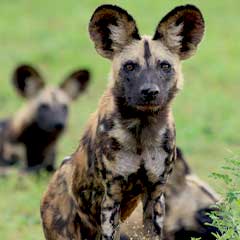
African Painted Dog Conservation
We support Lion Landscapes in their multi-year survey initiative to assess the status and conservation needs of Tanzania's painted dogs in an effort to bolster the population of this endangered species.



We support Lion Landscapes in their multi-year survey initiative to assess the status and conservation needs of Tanzania's painted dogs in an effort to bolster the population of this endangered species.
The African painted dog (also called African hunting dog or African wild dog) is now considered to be Endangered and rapidly declining. The principal threat to these highly social and wide-ranging predators is habitat fragmentation, which increases their contact with people and domestic animals. This contact results in human-wildlife conflict and often the killing of painted dogs, while also greatly increasing the likelihood of transmission of infectious disease.
Painted dogs naturally live at low densities and over very large territories, so few protected areas are big enough to maintain a long-term, sustainable population. Yet moving outside parks puts the dogs directly under threat from humans. At the same time, protected areas tend to have high densities of lions, which are a significant threat to pups and can cause population declines.
The Selous-Nyerere landscape in Tanzania is considered to have one of the last large populations of wild dogs left in Africa. However, almost nothing is known about this population, including its current status and whether the trend is stable, increasing, or decreasing.
Zoo New England is now supporting Lion Landscapes in this first step to develop effective conservation strategies for the protection of painted dogs – a multi-year survey assessment of the painted dog population in and around the park.
The African painted dog survey initiative within the Selous-Nyerere protected areas will help define and determine appropriate conservation actions on behalf of this large but almost completely unknown population of this highly Endangered canid.



